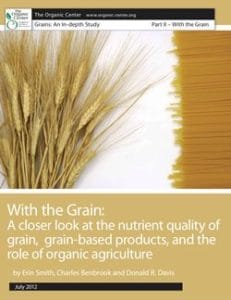 Scientists have known for years that many of the health-promoting nutrients in grain are lost before they reach the table. Consumer preference for fine white flour and grains (such as white rice) means that, on average, about 75% of the nutrients found in grains, including protein, fiber, vitamins, minerals and antioxidants, are left in the mill.
Scientists have known for years that many of the health-promoting nutrients in grain are lost before they reach the table. Consumer preference for fine white flour and grains (such as white rice) means that, on average, about 75% of the nutrients found in grains, including protein, fiber, vitamins, minerals and antioxidants, are left in the mill.
The factors that influence nutrient content are many and varied and some, such as climatic differences, are uncontrollable. But there are steps along the market chain from field to table where changes can be made to ensure bread is as nutrient rich as possible. A new report from The Organic Center explores grains and nutritional quality.
Organic farming systems do have impacts that could lead to greater nutrient content in grain crops. Conventional agricultural methods, with their abundance of certain soil nutrients, water, and other resources, produce grains that are less nutrient rich and/or less optimally balanced nutritionally. Soil nutrients in organic form—whether from compost, manure, or other decomposing organic matter—can meet the needs of a growing crop and are often more readily available to plant roots and the resulting crop.
In the field, the planting of varieties known to have higher nutrient content, including older varieties and landraces, is an important first step. The additional benefits of organic system management can lead to substantial differences in antioxidant and nutrient levels.
As demand continues to grow for organic grain-based products, yield growth will remain important and within reach, as scientists use breeding techniques to identify genes associated with high-nutrient levels in older varieties and work to incorporate just those genes in otherwise well adapted, high-yielding modern varieties.
You can find the full report here.

